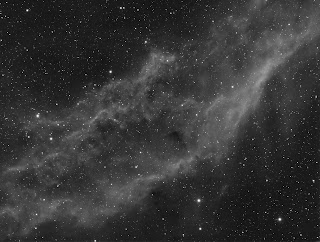When oriented 90 degrees from this orientation it resembles the State of California which it is commonly known as. It is a very popular object but only the second time for me - the first was four years ago. That was one of the first images I did with the Astronomik Ha Clip-In Filter. Ironically, I reprocessed that image eight months later when I tried PixInsight for the first time. That PI version is a great improvement. It is hard to compare with this version since I used a modified Hubble Palette but I think it is better. I really like the sharp wispy dendrites scattered throughout the gold region of the Nebula.
I chose to do it using narrowband filters as I needed an object that could be done when the moon is out since that is the only time it has been clear in the last two months. The SII (sulfur) came out really well. The Ha (hydrogen) was ok but there were some gradients most likely caused by wispy clouds and poor transparency. The OIII (oxygen) was not that good at all - it was barely visible and noisy. Attached is a link to my website that has the stacked data.
(link, https://astroquest1.blogspot.com/2022/01/ngc-1499-california-nebula-nb-with-rgb.html).
It may be that oxygen just is not that abundant in this nebula. The RGB data was pretty good, especially red, but I only used it for the stars.
As a result of the poor oxygen I did some PixelMath gymnastics to make a presentable combination. After numerous combinations with and without the oxygen I used: S - red; Ha - green; and S 40%, Ha 40%, OIII 20%. I use PixelMath for many other things as well such as bringing stars back and sharpening. Although I did not get the richness I hoped for, the stars came out well and the translucent detail was there. Also on the website link is the b&w luminosity layer. I attached it as some objects seem to show more detail in black and white in my opinion. This is one and the Horsehead in another.
As a result of the poor oxygen I did some PixelMath gymnastics to make a presentable combination. After numerous combinations with and without the oxygen I used: S - red; Ha - green; and S 40%, Ha 40%, OIII 20%. I use PixelMath for many other things as well such as bringing stars back and sharpening. Although I did not get the richness I hoped for, the stars came out well and the translucent detail was there. Also on the website link is the b&w luminosity layer. I attached it as some objects seem to show more detail in black and white in my opinion. This is one and the Horsehead in another.
http://astroquest1.blogspot.com/
https://www.astrobin.com/users/kurtzepp/collections/
http://youtube.com/c/AstroQuest1
NGC 1499 - California Nebula
Dates: 12-12-21, 12-13, 12-19, 12-20, 12-20, 1-3-22, 1-4, 1-7, 1-8
Hydrogen
Oxygen
Sulfur
NGC 1499 - California Nebula
Dates: 12-12-21, 12-13, 12-19, 12-20, 12-20, 1-3-22, 1-4, 1-7, 1-8
Camera: ZWO ASI1600MM-Pro
Telescope: Astro-Tech AT115EDT 115mm Refractor Telescope
Barlow: None
Focal Length: 805mm (644mm w/ FR)
f/7
Focal Reducer: 0.8x AstroTech Field Flatterner/Focal Reducer
Mount: Orion Sirius
Filter Wheel: ZWO EFW 8 x 1.25"
Filter: ZWO Ha, OIII, SII, R, G, B
Focuser: ZWO EAF
Autoguiding: ASI120 Mini attached to an Agena 50mm Guide Scope/ZWO 60mm Guidescope
Exposure: Ha 112 x 180, OIII 98 x 180, SII 93 x 180, R 60 x 60, G 59 x 60, B 46 x 60
Gain: 139
Offset 20
Sensor Temp: -10 C/-20 C
Processing: NINA, PixInsight, Photoshop, Topaz DeNoiseAI, Gradient Exterminator, StarXTerminator.
https://www.instagram.com/astroquest1/
http://astroquest1.blogspot.com/
https://www.astrobin.com/users/kurtzepp/collections/
http://youtube.com/c/AstroQuest1
Telescope: Astro-Tech AT115EDT 115mm Refractor Telescope
Barlow: None
Focal Length: 805mm (644mm w/ FR)
f/7
Focal Reducer: 0.8x AstroTech Field Flatterner/Focal Reducer
Mount: Orion Sirius
Filter Wheel: ZWO EFW 8 x 1.25"
Filter: ZWO Ha, OIII, SII, R, G, B
Focuser: ZWO EAF
Autoguiding: ASI120 Mini attached to an Agena 50mm Guide Scope/ZWO 60mm Guidescope
Exposure: Ha 112 x 180, OIII 98 x 180, SII 93 x 180, R 60 x 60, G 59 x 60, B 46 x 60
Gain: 139
Offset 20
Sensor Temp: -10 C/-20 C
Processing: NINA, PixInsight, Photoshop, Topaz DeNoiseAI, Gradient Exterminator, StarXTerminator.
https://www.instagram.com/astroquest1/
http://astroquest1.blogspot.com/
https://www.astrobin.com/users/kurtzepp/collections/
http://youtube.com/c/AstroQuest1
Luminosity





